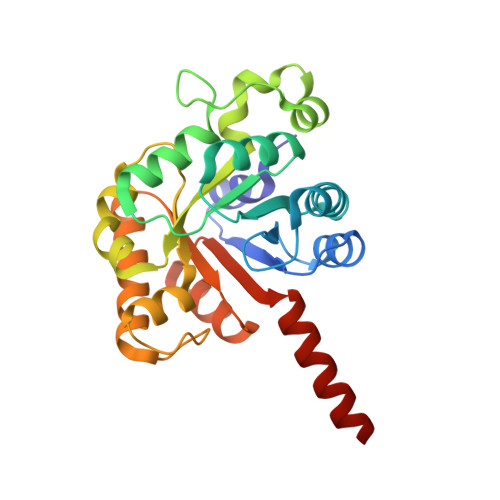Substrate Induced Movement of the Metal Cofactor between Active and Resting State.
Marsden, S.R., Wijma, H.J., Mohr, M.K.F., Justo, I., Hagedoorn, P.L., Laustsen, J., Jeffries, C.M., Svergun, D., Mestrom, L., McMillan, D.G.G., Bento, I., Hanefeld, U.(2022) Angew Chem Int Ed Engl 61: e202213338-e202213338
- PubMed: 36214476
- DOI: https://doi.org/10.1002/anie.202213338
- Primary Citation of Related Structures:
7NNK, 7NR1, 7NUJ, 7O5I, 7O5R, 7O5V, 7O5W, 7O87, 7O9R, 7OBU, 8ADQ - PubMed Abstract:
Regulation of enzyme activity is vital for living organisms. In metalloenzymes, far-reaching rearrangements of the protein scaffold are generally required to tune the metal cofactor's properties by allosteric regulation. Here structural analysis of hydroxyketoacid aldolase from Sphingomonas wittichii RW1 (SwHKA) revealed a dynamic movement of the metal cofactor between two coordination spheres without protein scaffold rearrangements. In its resting state configuration (M 2+ R ), the metal constitutes an integral part of the dimer interface within the overall hexameric assembly, but sterical constraints do not allow for substrate binding. Conversely, a second coordination sphere constitutes the catalytically active state (M 2+ A ) at 2.4 Å distance. Bidentate coordination of a ketoacid substrate to M 2+ A affords the overall lowest energy complex, which drives the transition from M 2+ R to M 2+ A . While not described earlier, this type of regulation may be widespread and largely overlooked due to low occupancy of some of its states in protein crystal structures.
Organizational Affiliation:
Biokatalyse, Afdeling Biotechnologie, Technische Universiteit Delft, van der Maasweg 9, 2629HZ, Delft, The Netherlands.
















